|
|
|
Sort Order |
|
|
|
Items / Page
|
|
|
|
|
|
|
| Srl | Item |
| 1 |
ID:
185883
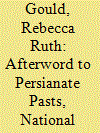

|
|
|
|
|
| Summary/Abstract |
What is the relevance of the Persianate as a category of analysis in a world wherein even world literature continues to be framed as the literary history of discrete nations? First coined by historian Marshall Hodgson in 1974, Persianate initially referred to cultures such as Georgian, Armenian, Chaghatay, Urdu, and Ottoman, which were heavily influenced lexically and culturally by Persian without themselves being related to Persian linguistically. Gradually, an additional meaning was grafted onto “Persianate,” which referenced cultures such as Judeo-Persian that were linguistically Persian but culturally diverse, bearing multiple alphabets, religions, and identities. These two meanings—the first grounded in cultural affinity and the second in linguistic origins—complement each other and ensure that the concept of the Persianate is reducible neither to language nor to identity.
|
|
|
|
|
|
|
|
|
|
|
|
|
|
|
|
| 2 |
ID:
185877
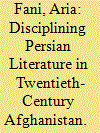

|
|
|
|
|
| Summary/Abstract |
How was Persian literature disciplinized in the twentieth century? This article addresses this question by focusing on twentieth-century Afghanistan and outlining the sociohistorical processes that helped to transform scholarly and literary production into a social enterprise. A major outcome of these underexamined processes was the making of Dāʾerat ol-maʿāref-e Āryānā (1949–79) in Kabul, the first modern encyclopedia produced in Persian. The article explains the multilayered significance of Āryānā's literary taxonomies, reading practices, and historiographical models that reified Persian literature as an object of academic study and national veneration in Afghanistan. A close reading of Āryānā's account of Persian literary history illustrates its complex relationship with both Iranian and Afghan nationalisms of the 1940s and 1950s and its contributors’ adherence to a modern methodology. The present study places Āryānā squarely within a transregional ecosystem that brought about the institutionalization of literature in Persian-speaking lands.
|
|
|
|
|
|
|
|
|
|
|
|
|
|
|
|
| 3 |
ID:
185880
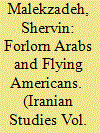

|
|
|
|
|
| Summary/Abstract |
Drawing upon three decades of postrevolutionary textbooks, this article traces the development of the Arab Muslim as a recurring character in the early elementary curriculum of the Islamic Republic, set against the historical context of Iranian modernization and state formation in the twentieth and twenty-first centuries. Sympathy for the Arab by the postrevolutionary state included a rebuke and an affirmation: Look at what has happened to the Arabs who were not able to defend their homes and their homeland, and look at what has not happened to us. Set against the Palestinian Arab figure are the accomplishments of American scientists and inventors who feature prominently in the postrevolutionary curriculum as sources of emulation for young readers. Star turns from Thomas Edison, Alexander Graham Bell, and Orville and Wilbur Wright invite a reconsideration of the role of the foreign Other in the construction of Iranian national identity, notably the expectation that the dispossessed constitute natural allies in Iran's ceaseless struggle against “the West.” Islamization of the primary school curriculum since 1979 has not come at the expense of Iranian national identity but as its expression, elucidating the ways postrevolutionary educational materials can serve as a repository for tracing the continuities and permutations in depicting the Arab or Western Other as well as different civilizational ethos of the Islamic and Persianate world across time.
|
|
|
|
|
|
|
|
|
|
|
|
|
|
|
|
| 4 |
ID:
185874
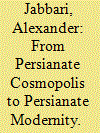

|
|
|
|
|
| Summary/Abstract |
This article examines twentieth-century Persian translations of Urdu-language works about Persian literature, focusing on two different Persian translations of an influential Urdu-language work on Persian literary history, Shiʿr al-ʿAjam (Poetry of the Persians), by Shibli Nuʿmani. The article offers a close, comparative reading of the Afghan and Iranian translations of Shiʿr al-ʿAjam in order to understand why two Persian translations of this voluminous text were published within such a short time period. These translations reveal how Indians, Afghans, and Iranians were invested in the same Persianate heritage, yet the emergence of a “Persianate modernity” undergirded by a cultural logic of nationalism rather than cosmopolitanism, along with Iran’s and Afghanistan’s differing relationships to India and Urdu, produced distinct approaches to translation.
|
|
|
|
|
|
|
|
|
|
|
|
|
|
|
|
| 5 |
ID:
185876


|
|
|
|
|
| Summary/Abstract |
Despite being in operation for a mere five years, the Soviet-era Tajik (Persian) journal Rahbar-i Dānish (1927–1932) was a key venue for exploring and debating the merits of Tajik literature in the context of new ideological and literary trends. Established litterateurs as well as literary newcomers published examples of their literature and literary criticism in this first Tajik monthly social, educational, and literary journal. The present article reviews the history of Rahbar-i Dānish and some of its authors to trace their influence on Tajik literature and literary criticism in the late 1920s and early 1930s. The article addresses the difficulties of creating a Soviet Tajik literature and scrutinizes the various genres featured in the literary section of the journal. Finally, it presents the trajectories of two literary newcomers, Jalāl al-Dīn Ikrām (who later became known as Jalol Ikromi) and Baḥr al-Dīn ʿAzīzī (who died in a Soviet prison in 1944), whose short stories were most prominent in Rahbar-i Dānish. This article is based on an almost complete set of the forty-five issues of the journal, published between August 1927 and March 1932.
|
|
|
|
|
|
|
|
|
|
|
|
|
|
|
|
| 6 |
ID:
185881


|
|
|
|
|
| Summary/Abstract |
This article introduces Julius Heise’s Marche Triomphale which reveals a history that was eliminated during the nineteenth century race theory publications. Beginning with an account of Iranians’ encounters with European military music, this article provides a brief history of Iranian military bands in European style, or the bands of muzikānchiān. It then addresses racial motivations behind a short account on Iranian music in 1885 by Victor Advielle, a French administrator. Arthur de Gobineau’s race theories were fashionable in nineteenth century Europe, and Victor Advielle used his fellow Artesian, Alfred Lemaire, to prove their racial superiority. Through Advielle’s account, Lemaire became the main figure of European music in Iran in the last quarter of the nineteenth century. The article proceeds with biographical information on two European musicians, Marco Brambilla (d.1867 in Tehran) and Julius Heise (d.1870 in Tehran), and uncovers the earliest known piece published for the bands of muzikānchiān: Marche Triomphale, À Sa Majesté Impériale Nassir-Ed-Din Shah Kadjar de Perse.
|
|
|
|
|
|
|
|
|
|
|
|
|
|
|
|
| 7 |
ID:
185882


|
|
|
|
|
| Summary/Abstract |
In contemporary Central Asia, Soviet-era authors are national heroes. Writers’ natal homes have become lovingly curated home-museums; statues of poets bedeck city squares; and schoolchildren write dictations from twentieth-century novels. Less often discussed in public, such writers also once belonged to the Soviet Writers’ Union, many of these poets called themselves “proletarian,” and their novels purported to imagine “revolution.” Poems about tractors rarely appear in today's anthologies, and new editions of 1930s novels excise the once-obligatory references to Stalin. In reaction to their Soviet-era canonization, some writers have been knocked from their pedestals, as recently happened to Hamza in Uzbekistan. Due to the political sensitivity of many Soviet writers in Uzbekistan, most serious scholarly attention has turned, since 1990, toward transitional Jadid writers of the early revolutionary years who were ultimately devoured by the official regime, such as Cho'lpon and Fitrat.
|
|
|
|
|
|
|
|
|
|
|
|
|
|
|
|
| 8 |
ID:
185879
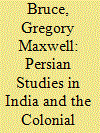

|
|
|
|
|
| Summary/Abstract |
The establishment of the colonial universities in India was a watershed moment for the history of Persian studies on the subcontinent. Despite the rise of English and vernacular literatures in the nineteenth century, Persian remained an essential language of instruction in colonial colleges, with generations of Indian students studying Persian to pass university examinations. By closely studying university calendars and courses, this article demonstrates that the colonial universities created and sustained an ecosystem for Persian studies throughout the colonial period, as Orientalists and increasingly Indian Persianists continued to invest in Persian instruction and curricular development. The breadth, diversity, refinement, and expansion of Persian college curricula—which included texts from the classical Persian canon and contemporary literature written by Iranians and Indians—testify to the continued fluidity and dynamism of Persian studies throughout the period. Such a phenomenon demonstrates that the debates and engagement around the Persian language in colonial India contradict its depiction as an obsolete or entirely classical language, and also that colonial college curricula influenced which texts were edited, compiled, printed, translated, and commented upon.
|
|
|
|
|
|
|
|
|
|
|
|
|
|
|
|
| 9 |
ID:
185873
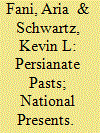

|
|
|
|
|
| Summary/Abstract |
Persianate pasts die hard. Despite the birth of nation-states, advent of colonialism, rise of national literatures, and emergence of new global technologies, the Persianate connections defining the texts, idioms, and vocabularies that bound together large swaths of Islamic Eurasia throughout the early-modern period continued to shape and inflect cultural and literary production in the late-nineteenth and twentieth centuries. If the sixteenth to eighteenth centuries established the high-water mark of Persianate transregionalism, then the following two centuries were defined not so much by the undoing of this world in toto, but by its redeployment, reimagining, and regeneration in new cultural guises and (trans)national contexts. Exchanges across borders and languages helped to articulate new meanings for Persian texts. Educational practices in British India and journalistic ones in Central Asia provided venues for Persianate norms to be preserved, contested, and consecrated. The internationalism of the Soviet East created a new avenue for dynamic conversations about the nature of Persianate heritage and traditions. While new national practices and political ecologies were taking shape across Afghanistan, the Caucasus, Iran, and Central and South Asia, refashionings of Persianate pasts persisted. It is an exploration of such refashionings and the people who participated in them that form the contents of this special issue.
|
|
|
|
|
|
|
|
|
|
|
|
|
|
|
|
| 10 |
ID:
185878
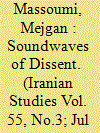

|
|
|
|
|
| Summary/Abstract |
In the decades of the 1960s and 1970s, sound recording technologies—including radio and cassettes—proliferated in Afghanistan and reached transnational lengths. While the state came to dominate these technologies, it could not prevent users from circumventing its censors with alternative perspectives and discourses. This article highlights the examples of Farīda ʿUsmān Anwarī, a noted radio announcer, producer, and journalist, and Aḥmad Ẓāhir, Afghanistan's most popular musical icon to date, to showcase the ways in which the Persianate literary canon served as the medium for sounding dissent amid the changing social and political dynamics of the time. Pushing the boundaries of recorded speech created an alternative space where dissent became possible and the strategic use of mass media paved the way for transnational sonic solidarities among a diverse community of listeners across the Persian-speaking world and beyond.
|
|
|
|
|
|
|
|
|
|
|
|
|
|
|
|
| 11 |
ID:
185875


|
|
|
|
|
| Summary/Abstract |
In scholarship on post-Persianate literary modernity, the emergence of the new institution of literature is often conflated with the delimitation and reification of national cultures as different manifestations of a single process. This article examines three anthologies of Persian literature from the interwar Persophone Soviet Union to reconsider the relationship between state cultural institutions’ procedures of literary modernization and nationalization. The anthologies mark out the stages by which classical Persian literature was portioned out to Soviet Eastern nationalities, and in particular the advent of Tajik literary history, but they also reveal the degree to which national literatures coevolved with new post-Persianate literary cosmopolitanisms and internationalisms.
|
|
|
|
|
|
|
|
|
|
|
|
|
|
|
|
| 12 |
ID:
185884


|
|
|
|
|
| Summary/Abstract |
This paper seeks to shed light on the metaphorical discourse of the secretive minority religion of Yārsān. Metaphor is demonstrated as a central rhetorical device, applied as a linguistic apparatus that serves the ideology of concealment. To express heterodox concepts, Yārsān texts principally employ two rhetorical devices, metaphor and lexical substitution. The metaphorical models objectively conceptualize highly abstract religious notions and serve to obscure heretical concepts that strongly vary from established orthodox beliefs. As for lexical substitution, the most frequent metaphorical models are verbalized using foreign loanwords that are not common in Kurdish dialects. Together, these strategies construct a highly puzzling and mysterious discourse that is too difficult for outsiders to unravel. It can be argued that the metaphorical discourse of Yārsān functions as an anti-language that effectively challenges the limitations of expression imposed by the orthodox mainstream in the medieval era. Yārsān followers are able to express non-expressible ideas and disguise them within complicated imageries.
|
|
|
|
|
|
|
|
|
|
|
|
|
|
|
|
|
|
|
|
|